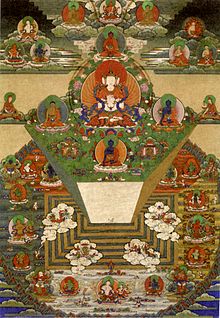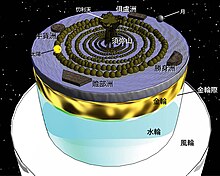Mount Meru


- For the mountain in Tanzania, see Mount Meru (Tanzania).
Mount Meru (Sanskrit: मेरु) (also called Sumeru i.e the "great Meru") is a sacred mountain in Hindu, Buddhist cosmology, and Jain mythology considered to be the center of all physical and spiritual universes. It is believed to be the abode of Brahma and other deities. Many Hindu temples, including Angkor Wat, the principal temple of Angkor in Cambodia, have been built as symbolic representations of the mountain.The mountain is said to be 80,000 yojanas high and located in Jambudvipa, one of the continents on earth in Hindu mythology (the magnitude of one yojana changed with time; Earth's circumference being 3200 jojanas according to Vārāha Mihira and slightly less in Āryabhatiya, but 5026.5 yojanas in Suryasiddhānta; Bhāgvata Purāna gives exorbitant dimensions, eg 80000 yojanas for Mt Meru , Mahābhārata gives 18000 yojanas as the extent of Jamboodvipa; hence it is not possible to determine the height of Mt Meru on these accounts).
Legends
Mount Meru finds mention innumerable times in Hindu lore. Some of the better-known legends are recounted here.
Meru, Vayu and Lanka
Legends say that Mount Meru and the wind god Vayu were good friends. However, the sage Narada approached Vayu and incited him to humble the mountain. Vayu blew with full force for one full year, but Meru was shielded by Garuda with his wings (he was flying high). However, after a year Garuda took respite for some time. Thus the apex of the mountain was broken and it fell into the sea and created the island of Sri Lanka.
Meru, Agastya and the Vindhya mountains
Another legend well-known to this day in India, is regarding the daily circumambulation of the sun around mount Meru, and involves the sage Agastya. The legend goes thus:
The Vindhya mountains that separate north and south India from each other once showed a tendency to grow so high as to obstruct the usual trajectory of the sun. This was accompanied by increasing vanity on the part of that mountain range, which demanded that Surya, the sun-God, circumambulate the Vindhya mountains daily, just as he does Mount Meru (identified by some as being the north pole). The need arose to subdue, by guile, the Vindhyas, and Agastya was chosen to do that.
Agastya journeyed from north to south, and on the way encountered the now impassable Vindhya mountains. He asked the mountain range to facilitate his passage across to the south. In reverence for so eminent a sage as Agastya, the Vindhya mountains bent low enough to enable the sage and his family to cross over and enter south India. The Vindhya range also promised not to increase in height until Agastya and his family returned to the north. Agastya settled permanently in the south, and the Vindhya range, true to its word, never grew further. Thus, Agastya accomplished by guile something that would have been impossible to accomplish by force.
Beliefs
The legends, puranas and Hindu epics frequently state that Surya, the sun-God, circumambulates Mount Meru every day. In late 19th c. when it was believed that Aryans may have had their original home Urheimat in North Europe, it was thought that Mount Meru may actually refer to the "center of the world."

The Iranians claim that the Aryans came from Mount Hara. Har is another name of Shiva, who has His abode in this mountain. Some beliefs, local to that area of the Himalayas, associate mythical Mount Meru with a mountain called Kailasa near the Lake Manasarovar in Tibet,which can be traced to some later layers of Mahabharata.
For the equivalent central mountain in Buddhist cosmology, see Sumeru.
Literary References
In the novel Far, Far the Mountain Peak by John Masters the central character Peter Savage becomes obsessed by the task of making the first ascent of a newly-discovered mountain in the north-west part of the then British India. The mountain is named Meru, in a conscious reference to the legendary mountain: "There have always been legends in Asia about a sacred mountain somewhere in Western Tibet, and it has always been called Meru, though no one has definitely found it ... so they are going to call this one Meru..." (Penguin edition, p. 78).
In his poem Meru, William Butler Yeats has both named his poem after the mountain, and also refers to "Hermits upon Mount Meru or Everest."[1]
Identification of Mount Meru
Scholars have identified Mount Meru or Sumeru with the Pamirs, north-east of Kashmir [2]. In epic times, it had formed the parts of Ancient Kamboja--more precisely, the Parama Kamboja of the epic Mahabharata (II.2.27) [3].
All modern scholars have tried to locate Mt Meru somewhere in Central Asia, but there are explicit references of it being in the middle of the Earth. Suryasiddhānta mentions that Mt Meru lies in 'the middle of the Earth' ("bhoogola-madhya") in the land of the Jamboonada. E. Burgess translates "bhoogola-madhya" as "the centre of the earth-globe" and not as 'bhoo-madhya' which is used for equator in Sanskrit and Hindi texts. Narpatijayacharyā, a mediaeval work of 9th century, based on mostly unpublished texts of Yāmala Tantra, mentions "Sumeruḥ Prithvī-madhye shrūyate drishyate na tu" ('Su-meru is heard to be in the middle of the Earth, but is not seen there'), which implies that middle of earth meant either the middle of surface landmass or the middle of entire surface, ie the equator, because the author could not go to the centre of earth-globe to see anything[4]. In the same chapter, description of Prithvi-Koormachakra shows that this mediaeval author had no knowledge of any country outside India except in the vicinity. Therefore, he looked for Mt Meru in the middle of India and could not find it there. Vārāha Mihira, in his Panch-siddhāntikā, locates Mt Meru at the North Pole. Suryasiddhānta, however, mentions a Mt Meru in the middle of Earth, besides a Sumeru and a Kumeru at both poles. Therefore, Sumeru was used both for North Pole as well as for the central Mt Meru by ancient authors. There is a town Meru at the foot of Mt Kenya at the equator, another Mt Meru lying in neighbouring Tanzania, a place named Kinyan-giri is in Tanzania,which translates as Mt Kinyan or Kenya, etc. Relations of these Sanskrit names in central Africa to Indian Meru is not clear. Clyde Winters claims to read the problematic Meroitic language of ancient Kushites of Sudan as a cognate of the Tochārian language of Kushānas of Central Asia, which is an Indo-European language of the western kentum branch. If his decipherment is valid, then the ancient city of Merœ eulogized by Herodotus may be related to Mt Meru in some way[5].
Notes
- ^ "Meru". Retrieved on 30 October, 2007.
- ^ The Geopolitics of South Asia: From Early Empires to the Nuclear Age, 2003, p 16, Graham P. Chapman - Social Science; The Pamirs and the Source of the Oxus, p 15, George Nathaniel Curzon; The Hindu World: An Encyclopedic Survey of Hinduism, 1968, p 184, Benjamin Walker - Hinduism; Ancient Indian Tradition & Mythology: Purāṇas in Translation, 1969, p 56, Jagdish Lal Shastri, Arnold Kunst, G. P. Bhatt, Ganesh Vasudeo Tagare - Oriental literature; Journal of the K.R. Cama Oriental Institute, 1928, p 38, K.R. Cama Oriental Institute - Iranian philology; The Occult in Russian and Soviet Culture, 1997, p 175, Bernice Glatzer Rosenthal - History; Geographical Concepts in Ancient India, 1967, p 50, Bechan Dube - India; Geographical Data in the Early Purāṇas: A Critical Study, 1972, p 2, Dr M. R. Singh - India; Studies in the Proto-history of India, 1971, p 17, Dr Dvārakā Prasāda Miśra - India.
- ^ The Deeds of Harsha: Being a Cultural Study of Bāṇa's Harshacharita, 1969, p 199, Dr Vasudeva Sharana Agrawala; Foundations of Indian Culture, 1984, p 20, Govind Chandra Pande - History; Problems of Ancient India, 2000, p 1-8, K. D. Sethna; Proceedings and Transactions of the All-India Oriental Conference, 1930, p 108; Geographical and Economic Studies in the Mahābhārata: Upāyana Parva, 1945, p 37, Dr Moti Chandra - India; For Pamirs/Badakshan = Kamboja, see also: The History and Culture of the Indian People, 1977, p 264, Dr Ramesh Chandra Majumdar, Dr A. D. Pusalkar, Bharatiya Vidya Bhavan - India; Asoka and His Inscriptions, 1968, p 95, B. M. Barua, I. N. Topa; Journal of the Asiatic Society, 1940, p 37, India) Asiatic Society (Calcutta, Royal Asiatic Society of Bengal - Asia.
- ^ cf. second verse of Koorma-chakra in the book Narpatijayacharyā
- ^ http://www.geocities.com/Tokyo/Bay/7051/mero.htm
Bibliography
- Narpatijayacharyā, commentary by Ganeshdatta Pathak, Cublished by Chowkhambha Sanskrit Sansthana, Varanasi, India, PIN-221001
See also
External links
- Description of Mount Meru in the Devi-bhagavata-purana 12
- The City on the Edge of Forever
- Painting of Mount Meru found in Buddhist cave sanctuary in Chinese Turkestan
- Mount Meru in Encyclopedia of Buddhist Iconography 12
- Sacred Geography of North Polar Regions

